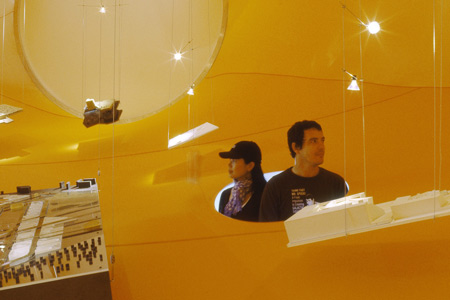While useful in many ways, this seems to me an overly simplistic definition, as if architects simply delineate inside from outside, creating a subset and choosing from what Cache terms a multiplicity of vectors to create walls, windows and buildings. Perhaps I am misinterpreting his definition, but Cache seems to mention only in passing that architecture shapes the way in which we navigate spaces. He touches on this when he says that “it is the flatness of the stage that makes choreography probable, just as it is the flatness of the stadium that increases the probability of athletics” [2]. But don’t architects, in their work, create spaces and not simply frames and subsets?
Cache’s definition of architecture certainly doesn’t preclude the idea that an architect (or architecture) creates new ways of interacting with space, it simply doesn’t emphasize what seems to me to be an integral objective of architecture. Think of the way that the design of a gallery or museum encourages you to move through it in various ways. This is not simply about function – regardless of what a building or space is meant to do, it shapes the way in which we interact with that space, presenting various (and hopefully variable) possibilities for navigating the world. I just wanted to point this out, perhaps as an addition to Cache's definition. I'm certainly not overly familiar with architectural theory and so maybe this has been written on at length already.
As an interesting supplement to my argument I thought I'd share this project I came across a while ago. A group called Magma Architecture created an installation for an exhibition of their work at the Berlinische Gallery in Berlin. I think it happened a few years ago. It's worth checking out, the article about it can be found at: http://www.dezeen.com/2009/02/11/head-in-by-magma-architecture/
-Ashley Arostegui
Notes:
[1] Bernard Cache, Earth Moves, p. 22.
[2] Ibid., 24.

-Ashley Arostegui
Notes:
[1] Bernard Cache, Earth Moves, p. 22.
[2] Ibid., 24.
Ashley, I'm not sure it's accurate to describe Deleuze's concept of the fold in terms of sets and subsets, which sounds more Badiou than Deleuze. (Badiou is a contemporary of Deleuze's, who proposes a mathematical ontology based in algebra and sets in opposition to Deleuze's differential calculus and manifolds.) I would add here too that your description of the "separation of space" and then "arrangement of interval" is precisely what we don't find – according to Deleuze and Guattari – in the new geometry heralded by the mathematician Bernhard Riemann. The interval is no longer subjected to an series of extrinsic points that allow it to be contained and measured. For this reason, the very notion of interval can take on a new meaning or value. It is this new conception of interval that Cache attempts to utilize in his ideas on contemporary architectural practice; a practice meant to be sensitive to the variations and intensities that make up our environment or milieu. Sam
ReplyDeleteThanks for the clarification, Sam. When I was referring to sets and subsets I was actually drawing on what Anne Boyman wrote in the preface. She refers to Deleuze's writing on film when she, towards the end of the preface, likens Cache's frame images to the idea of the frame that Deleuze uses in the Cinema writings: "the delimitation from a larger indeterminacy of those elements of which a film is the composition." (xi) I certainly didn't mean to imply a closed, finite interval, though I definitely don't have a very firm grasp on all this math. I think that I didn't express this clearly, but precisely what interests me in architecture is the possibility of infinite variation in the interaction with a space, and the architect's creation of those possibilities.
ReplyDeleteI am very interested in the idea of Badiou's ontology now, though. I think I'll look into it.
ReplyDeleteI wouldn't, if I were you. However, if you are curious to know more about Badiou vis-a-vis Deleuze (as well as axiomatic set theory v differential calculus and manifold), see the following article by Daniel Smith: http://nessie-philo.com/Files/daniel_w_smith__mathematics_and__the_theory_of_multiplicities.pdf. Smith is a good source for Deleuze on this and a number of other topics. (He translated Essays Critical and Clinical and wrote the excellent introduction to that collection.)
ReplyDelete